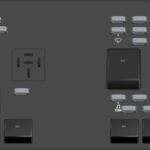The world of automotive diagnostics is complex, especially when diving into the specifics of different vehicle manufacturers. For those working with VAG (Volkswagen Audi Group) vehicles, understanding specific OBD2 requests is crucial for effective troubleshooting and repair. One such request that often surfaces in discussions among automotive technicians and enthusiasts is 22f1a5 Obd2. This article aims to delve into the intricacies of this request, exploring its potential meaning, the data it might retrieve, and the challenges in interpreting the results.
While the exact official documentation for the 22F1A5 OBD2 request within VAG vehicles may be elusive in publicly accessible resources, its context within online forums and technical discussions points towards its use in retrieving Diagnostic Trouble Codes (DTCs) and associated detailed data. Understanding the structure of the response to this request is key to unlocking valuable diagnostic information.
Analyzing the Detail Records of VAG DTCs
Let’s examine an example of a detailed record interpretation, as discussed in the original forum post, to understand the potential data structure behind the 22F1A5 OBD2 request:
Consider the data string: 19 06 20 04 00 FF. Breaking this down based on interpretations from expert discussions and diagnostic tool outputs, we can infer the following structure:
-
59 06 (=> PID + 0x40): This likely represents a Parameter ID (PID) with an offset of 0x40. PIDs are used in OBD2 to request specific data parameters. In this context, it’s part of the detailed error record structure.
-
20 04 00 08 (=> Error Code with Mask): This segment appears to be the core error code itself. Interpreted as a VAG fault code 2098176, it correlates to the ISO P33E500 standard. The description, according to resources like CarPort Free Edition, is: “Quick battery charging (DC) Charge stn., initialization error, error_initialisation_fast_charging.” This immediately gives us context – a problem related to DC fast charging in an electric vehicle. The mask
01 02 03following the error code is speculated to represent:02: Error priority03: Error frequency
-
02 58 00 05 8E 00 00 1F A8 FA E3: This longer sequence likely contains additional contextual data related to the error event. Possible interpretations include:
58: Potentially a “verlernzähler” or unlearning counter, possibly related to how many times the error has occurred or been reset.00 05 8E: Likely Kilometer reading (odometer) at the time of the error.1F A8 FA E3: This is strongly suspected to be a timestamp, indicating the date and time when the error occurred. Decoding this timestamp format accurately can be challenging.
-
7A (=> Delimiter?): The byte
7Amight act as a delimiter, separating different sections of the detailed error record. -
1D E5 00 01 (=> PID ‘1D E5’ – Chademo Version?): This section introduces another PID, ‘1D E5’. Interestingly, it’s speculated to be related to the Chademo charging standard version. The data bytes
00 01following it are linked to the error event’s context at the time of occurrence. The reason for including Chademo version data within a general charging error might be specific to VAG’s diagnostic data logging. -
1D EF 00 00 00 00 00 00 00 00 00 00 00 00 04 01 (=> PID ‘1D EF’ – DC Charging Session Data): Finally, PID ‘1D EF’ is present, believed to represent DC charging session data from the charging station. The subsequent 14 bytes of data likely contain parameters recorded at the time of the fault, offering a deeper insight into the charging conditions when the error was triggered.
This detailed breakdown, while based on interpretation and community knowledge, highlights the complexity of the data potentially retrieved by the 22F1A5 OBD2 request and similar VAG diagnostic queries.
The Challenge of Timestamp Decoding and Data Source
One of the significant hurdles in fully utilizing the data from 22F1A5 OBD2 and similar requests is accurately decoding the timestamp. Different PID timestamps within VAG systems may employ varying encoding methods. While some information might exist, as referenced in the original discussion concerning PID 22 02 BD (SG 8C), these may not universally apply to all timestamps encountered in detailed error records.
Furthermore, a crucial question remains: where can one reliably obtain comprehensive documentation on VAG specific DTC texts and the detailed data structures associated with requests like 22F1A5 OBD2? While online forums and communities provide valuable insights and reverse-engineering efforts, official documentation would be the gold standard.
One potential source mentioned is Erwin (electronic repair and workshop information), the official service information system for Volkswagen Group brands. However, the availability of such detailed diagnostic data within Erwin and the effort required to navigate and extract this information are uncertain. Diagnostic tool manufacturers like VCDS and CarPort likely possess in-depth knowledge, but this information is often proprietary.
Conclusion: Continuing the Diagnostic Deep Dive
The 22F1A5 OBD2 request serves as a fascinating case study in the intricacies of automotive diagnostics, particularly within the VAG ecosystem. While the exact purpose and data structure require further investigation and potentially reverse engineering, analyzing example data strings and leveraging community knowledge can provide valuable insights.
For automotive professionals and enthusiasts working with VAG vehicles, understanding requests like 22F1A5 OBD2 is essential for advanced diagnostics and troubleshooting, especially in increasingly complex systems like those found in electric vehicles. Continued research, community collaboration, and exploration of resources like Erwin are key steps in fully unlocking the potential of these diagnostic requests.
